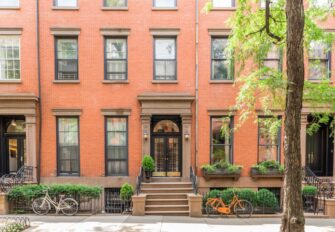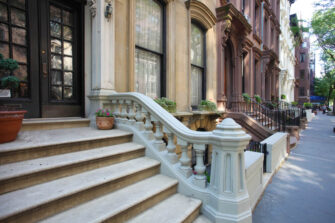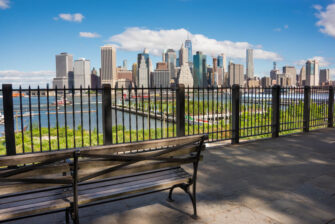Brooklyn Heights Personal Injury Attorney

The historic brownstones of Brooklyn Heights are a signature sight of this posh residential neighborhood known for its tree-lined promenade along the East River and steep real estate. In and around the history lives an area rich with antique stores, unique housewares, and more.
Key Features of the Area
Table of Contents
Brooklyn Heights has been called America’s first suburb because of its proximity to Manhattan. Its brownstones lend this area of Northwestern Brooklyn an elegant feel, many with window boxes, wrought-iron railings along the front steps (or “stoop”), tall windows, facades in different reddish-brown shades, and private patios and gardens. It also has many churches. The architecture mixes styles including Victorian Gothic, Italianate, Second Empire and Greek Revival.
Boutiques range from books and music to contemporary clothing and housewares. The Brooklyn Women’s Exchange, founded in 1854, is a craft and gift shop that features unique designs from independent craftspeople (with 70 cents of every dollar going directly to the artisans).
Bistros here offer plenty of sidewalk seating in warmer weather, and foodies will find everything from organic gluten-free chocolate truffles to pitas and more mainstream fare. The iconic Middle Eastern grocery store Sahadi’s on Atlantic Avenue has been a neighborhood mainstay since 1948, featuring bulk containers of dried fruits, imported olives, and nuts; bins of grains and spices; and barrels of coffee beans.
The Brooklyn Heights Promenade provides one of New York City’s most stunning views: downtown Manhattan across the East River, with the Brooklyn and Manhattan bridges to the right and Governors Island and the Statue of Liberty to the left.
Commuters and visitors alike can take the NYC Ferry from Brooklyn Bridge Park to Manhattan as well as South Brooklyn. Bicyclists and pedestrians also enjoy strolling along the boardwalk of the Brooklyn Bridge.
Brief History of Brooklyn Heights
 1814: Robert Fulton’s New York and Brooklyn Steam Ferry Boat Company begins regular ferry service connecting the area to Manhattan.
1814: Robert Fulton’s New York and Brooklyn Steam Ferry Boat Company begins regular ferry service connecting the area to Manhattan.
1816: Hezekiah Beers Pierrepont, one of the area’s main landowners, influences Brooklyn receiving a charter from the state as a village, leading to sidewalks, water pumps and the streets’ grid-like pattern.
1823: Subdivided farmland in the area is advertised as a “country retreat” for Manhattanites.
1890: Brooklyn Heights is almost completely developed and becomes a cultural and financial center.
1883: The Brooklyn Bridge is completed, making Brooklyn (and Brooklyn Heights in particular) more accessible from Manhattan.
1940s to 1950s: Under the Housing Act of 1949, the city proposes replacing some of the historic buildings with luxury apartment buildings.
1965: Brooklyn Heights is the first neighborhood protected by the 1965 Landmarks Preservation Law of New York City.
Location & Tourism
 The South Brooklyn route of NYC Ferry connects the borough’s coastal residential communities and waterfront parks to Midtown and the Financial District. Access the ferry from Brooklyn Bridge Park Pier 6 at Atlantic Avenue. One-way fare is $2.75.
The South Brooklyn route of NYC Ferry connects the borough’s coastal residential communities and waterfront parks to Midtown and the Financial District. Access the ferry from Brooklyn Bridge Park Pier 6 at Atlantic Avenue. One-way fare is $2.75.
Interesting Facts About Brooklyn Heights
- Authors Norman Mailer and Truman Capote each lived in Brooklyn Heights. Other famous residents include historian and activist W.E.B. Du Bois, playwright Arthur Miller, and poet, essayist, and journalist Walt Whitman. Whitman even edited the local newspaper The Brooklyn Eagle.
- During the Revolutionary War’s Battle of Long Island, Gen. George Washington retreated to Brooklyn Heights.
- President Abraham Lincoln once prayed at Plymouth Church, located on Orange Street between Henry and Hicks streets. Founded by abolitionist, social reformer and clergyman Henry Ward Beecher, the church served as a sanctuary for runaway slaves using the Underground Railroad.
- Jackie Robinson, the first African American to play in Major League Baseball in the modern era, signed his major league contract here when the executive offices of the Brooklyn Dodgers were located at 215 Montague St.
Directions to Belluck & Fox from Brooklyn Heights
Belluck & Fox’s New York personal injury law office is located in Midtown at 546 Fifth Ave., 5th Floor, New York NY 10036. From Brooklyn Heights, take the Brooklyn Bridge into Manhattan from Cadman Plaza West and Prospect Street. Then take the FDR Drive north to First Avenue/United Nations Plaza (East 42nd Street). Turn right through the First Avenue Tunnel and left onto East 47th Street. Then turn left onto Fifth Avenue.
Our law office also is accessible by taking the 4 subway train from Borough Hall to Grand Central/42nd Street.
Contact our New York City Mesothelioma Law Firm
If you or a loved one has sustained an injury due to someone else’s negligence, you need to speak with a competent New York mesothelioma lawyer about your right to compensation. At Belluck & Fox, we offer free initial consultations for our clients in Brooklyn Heights and surrounding areas and we work on a contingency fee, so you don’t have to pay anything to get started. In fact, we only collect fees if we recover money in your case.
Please call us today at (212) 681-1575 to learn more about how we can assist you.
Other Areas We Serve In Brooklyn, NY:
- Bushwick
- Greenpoint